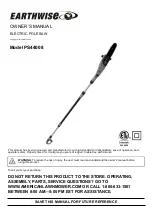
F1 Table Saw
10
equipment-grounding conductor. If repair or replacement of the electric cord or plug is necessary, do not
connect the equipment-grounding conductor to a live terminal.
Check with a qualified electrician or service personnel if the grounding instructions are not completely
understood, or if in doubt as to whether the tool is properly grounded.
Use only 3-wire extension cords that have 3-prong grounding plugs and 3 pole receptacles that accept the
tool's plug.
Repair or replace damaged or worn cord immediately.
Grounded, cord-connected tools intended for use on a supply circuit having a nominal rating less than 150
volts:
This tool is intended for use on a circuit that has an outlet that looks like the one illustrated in Sketch A in
Fig. 1. The tool has a grounding plug that looks like the plug illustrated in Sketch A in Fig. 1. A temporary
adapter, which looks like the adapter illustrated in Sketch B and C, may be used to connect this plug to a 2
pole receptacle as shown in Sketch B if a properly grounded outlet is not available. The temporary adapter
should be used only until a properly grounded outlet can be installed by a qualified electrician.
This adapter
is not permitted in Canada.
The green-colored rigid ear, lug, and the like, extending from the adapter must
be connected to a permanent ground such as a properly grounded outlet box.
Grounded, cord-connected tools intended for use on a supply circuit having a nominal rating between 150 –
250 volts, inclusive:
This tool is intended for use on a circuit that has an outlet that looks like the one illustrated in Sketch D. The
tool has a grounding plug that looks like the plug illustrated in Sketch D. Make sure the tool is connected to
an outlet having the same configuration as the plug. No adapter is available or should be used with this tool.
If the tool must be reconnected for use on a different type of electric circuit, the reconnection should be
made by qualified service personnel; and after reconnection, the tool should comply with all local codes and
ordinances.
Proposition 65 Warning of Harmful Exposure
Some dust created by power sanding, sawing, grinding, drilling and other construction activities contains
chemicals known to cause cancer, birth defects or other reproductive harm. Some examples of these
chemicals are:
Lead from lead-based paint.
Crystalline silica from bricks, cement, and other masonry products.
Arsenic and chromium from chemically treated lumber.
Your risk of exposure varies, depending on how often you do this type of work. To reduce your exposure to
these chemicals, work in a well-ventilated area and work with approved safety equipment, such as face or
dust masks that are specifically designed to filter out microscopic particles.
French
AVERTISSEMENT!
Pour votre propre sécurité, lisez le manuel d'instructions avant d'utiliser la scie à table.
(a) DANGER - Ne placez jamais vos mains à proximité ou en ligne avec la lame de scie.
(b) AVERTISSEMENT - "Porter une protection oculaire" ou le signe M004 de la norme ISO 7010.
(c) AVERTISSEMENT - Toujours utiliser un protecteur de lame de scie, un couteau diviseur et un dispositif
anti-retour pour chaque opération pour laquelle il peut être utilisé, y compris tout au long du sciage.
Summary of Contents for Fusion F1
Page 26: ...F1 Table Saw 26 Put on the fence and calibrate it by loosening and moving the scale...
Page 33: ...F1 Table Saw 33 Parts Table Fence Rails...
Page 34: ...F1 Table Saw 34 Blade Guard Miter Gauge...
Page 35: ...F1 Table Saw 35 Fence...
Page 36: ...F1 Table Saw 36 Base...
Page 37: ...F1 Table Saw 37 Motor Trunnions...
Page 38: ...F1 Table Saw 38 Cabinet Arbor...











































